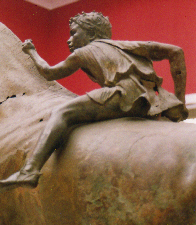Here is the original gold from Mycenae, (you will see reproductions in the museum at Mycenae) it is absolutely fabulous. In pride of place are the stunning gold death masks, including the one which Schliemann declared was the mask of Agamemnon. It is in fact much earlier, dating from the 16th century BC. On the left are the gold sheet coverings from two dead babies (16th century BC). On the right are the wonderful gold and ivory bull rhyton and lion rhyton
I love the 13th century BC plaster mask (right) from Mycenae, possibly a goddess or sphinx, with painted features.
The frescoes from Tyrins are
a fragment of the vivid wall paintings which decorated
the Palaces.
Look out for the not very complete boar's tooth helmet, no. 6568, on the right hand side by the entrance to the side room. Homer describes these in the Iliad.






